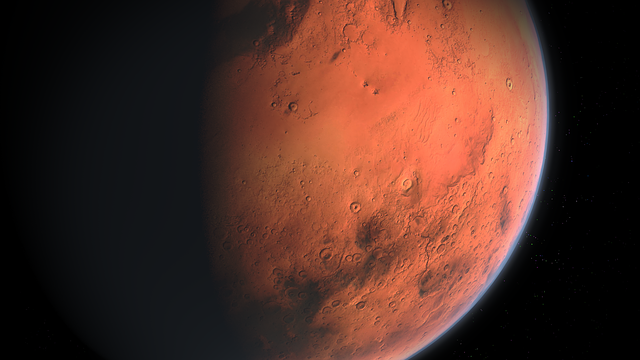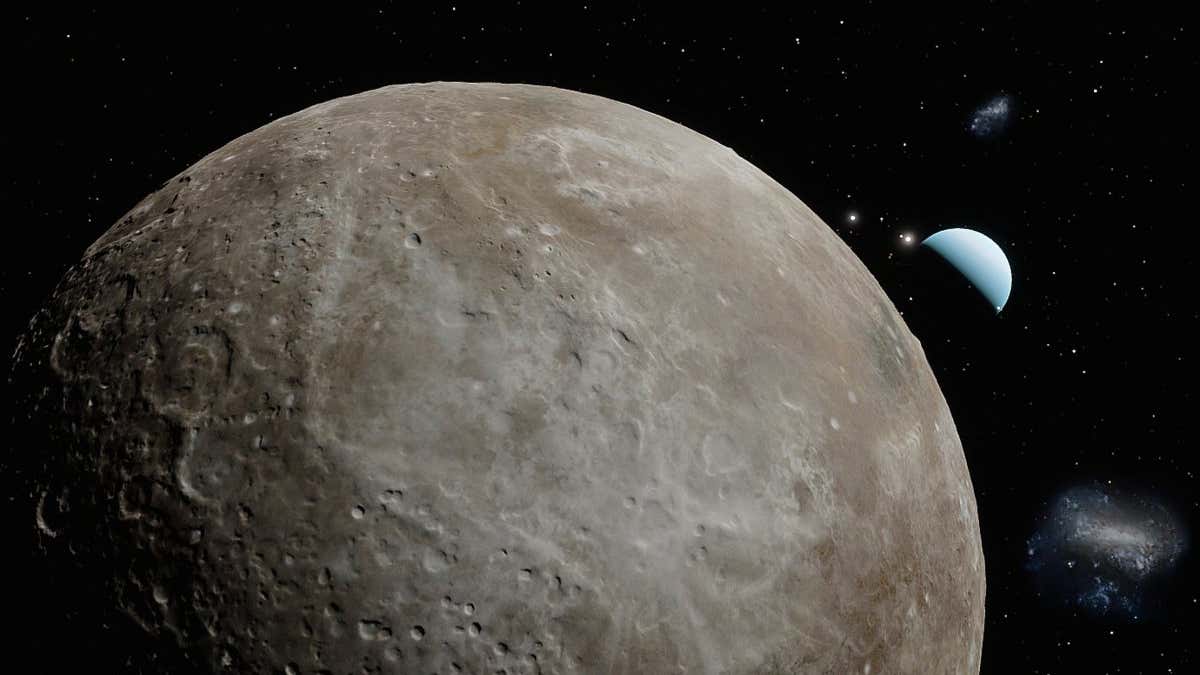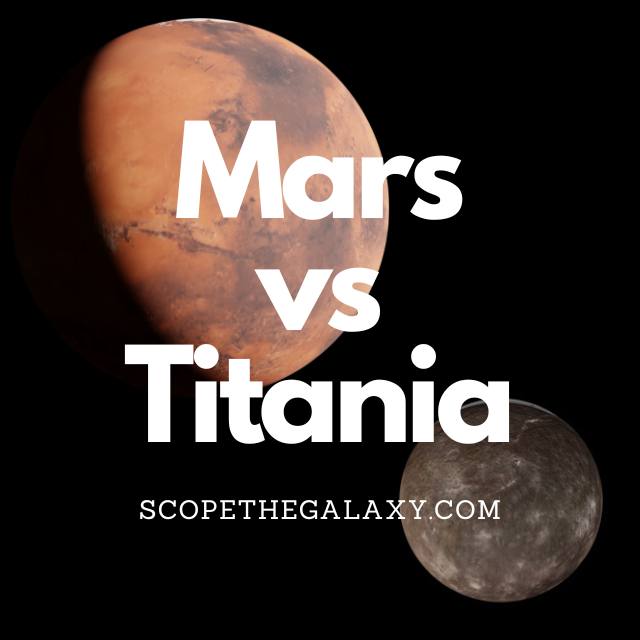*This post may contain affiliate links. This means we may make a commission if you purchase an item using one of our links*
The main differences between Mars and Titania are that Mars is the 4th closest planet to the Sun whilst Titania is a natural satellite that orbits Uranus which is the 7th farthest planet from the Sun, Titania is smaller with a diameter of 1576.8km whereas Mars has a diameter of 6,779km and Mars has 2 moons orbiting it whilst Titania has no other objects orbiting it.
There are various other differences between these two celestial bodies so, continue reading for a more detailed look at each entity along with their similarities and differences below.
What Is The Planet Mars?
Table of Contents

Mars, also known as the red planet, is the celestial object that’s the front runner in our entire solar system to become a possible new home for us if terraformed. It is also the 4th farthest planet from the Sun and is one of 4 main line terrestrial planets (not including Pluto) in our solar system.
This means that one year on Mars will take roughly 687 Earth days and a day on Mars is roughly the same as Earth at 24 hours and 37 minutes. It’s axial tilt is also very similar to that of Earth where it is positioned around 25 degrees to the right.
It may not be the largest terrestrial world in our solar system as its diameter is only 6,779km but, it does have the most moons amongst the normal terrestrial planet where two, namely Deimos and Phobos, are currently orbiting the red planet.
Like Earth and the other terrestrial worlds, Mars does have an atmosphere, certainly more visible than that on Mercury but, when compared to Earth’s it is merely 1% of its volume.
As a result it is more susceptible to larger debris striking its surface and is unable to trap in too much heat either. This is why it’s on the colder side with a temperature of around -65 degrees Celsius on average. On the contrary its core is significantly hotter at 1,350 degrees Celsius.
Mars is probably the most explored planet outside of our own, with a multitude of rovers like Sojourner (1997–1997), Opportunity (2004–2018), Spirit (2004–2010), Curiosity (2012–), and Perseverance (2021–) that have landed on the Martian soil to explore it.
Billionaires like Elon Musk and even Jeff Bezos are trying for an opportunity to genuinely have astronauts land on the Martian soil, possibly as early as 2029 so, Mars clearly has a lot interested in its terrain, as a potential substitute for Earth in the future.
What Is The Moon Titania?

Titania is the biggest of Uranus’s moons, with a circumference of 4,956km and a diameter of 1576.8km.
The high density of this moon suggests that it most likely formed from a collection of dust and debris leftover from the formation of Uranus or from the debris created in the collision that reportedly tilted Uranus onto its side. As a result Titania has a mass of 3.4 × 10^21 kg.
First discovered on 11th January 1787 (the same day as the discovery of Oberon, the second biggest moon of Uranus) by British astronomer William Herschel, the name “Titania” comes from the Shakespeare play, A Midsummer Night’s Dream. (Most of Uranus’ moons are named after Shakespeare’s characters.)
Having observed Titania for many years, scientists theorize that its composition is likely to be equal parts ice and rock, the latter of which may contain carbonaceous materials and organic compounds.
Research suggests that the moon most likely has a rocky core (accounting for 66% of the moon’s radius) and an icy mantle. If the mantle contains ammonia, it will act as antifreeze and make it possible for liquid water to exist. In this instance, the moon could possess a layer of liquid ocean around 50km thick.
Titania tilts slightly towards the equator of Uranus and is tidally locked to its planet. This means a Titania day is 8 days and 17 hours which would be the same for its orbital cycle. Titania has an average temperature of -203 degrees Celsius.
The planet Uranus is also tilted, with the moons orbiting on the equatorial plane, giving it extreme seasons. On Titania, the north and south poles experience 42 years of complete sunshine followed by 42 years of total darkness.
Scientists have observed the presence of large amounts of carbon dioxide, suggesting this may be the primary component of this moon’s atmosphere. Thanks to the tilted orbit, and a concentration of solar radiation from the poles, Titania probably maintains a carbon dioxide cycle, similar to the hydrogen cycle on Earth.
Similarities Between Mars And Titania
Titania and Mars do have their odd few similarities, which in this case includes the below:
- Both have a hotter central core.
- Both have an atmosphere and a rocky surface.
- Both are a spherical shape.
- Both are part of the same solar system.
- Both have no rings surrounding them.
- Neither have tectonic plate activity.
Differences Between Mars And Titania
As for the differences between thee two, they include the below.
- Titania orbits Uranus whilst Mars only orbits the Sun.
- Mars is a terrestrial planet whilst Titania is a terrestrial based natural satellite.
- Mars has 2 moons whilst Titania has 0.
- Mars has a diameter of 6,779km whilst Titania’s diameter is 1,576.8km.
- Titania has a very thin exosphere composed mostly of carbon dioxide whilst Mars has an atmosphere that is 1% of Earth’s thickness composed of 95% carbon dioxide 2.6% nitrogen and 1.9% argon.
- A day on Titania takes 8 days 17 hours whilst a Mars day is 24 hours 37 minutes.
- It takes Titania 8 days 17 hours to orbit Uranus and the Sun in 84 years whilst Mars orbits the Sun in 687 days.
- Mars has an axial tilt of 25 degrees whilst Titania’s axial tilt is closer to 0.
- Titania’s average temperature is around -203 degrees Celsius whilst Mars has an average temperature of – 65 degrees Celsius.
- Mars’ density is 3.93 g/cm³ whilst Titania’s density is 1.71 g/cm³.
- Mars’ mass is 6.39 × 10^23 kg whilst Titania’s mass is 3.4 × 10^21 kg.
- Titania’s gravitational strength is 0.367 m/s² whilst Mars’ is 3.721 m/s²
- Titania is tidally locked to Uranus whilst Mars is is not tidally locked to any entity.
- Mars has a magnetosphere whilst Titania does not.
- Titania may have water within its surface.
Summary
Mars and Titania do have their odd few similarities such as their rocky nature’s and their generally thinner atmosphere, however, they have their fair share of differences too.
Whether it be in regards to size, mass, gravitational strength, density, the number of object that orbit them and more, these two are designed to function very differently from one another within our solar system and genuinely do so when all of their features are broken down.

